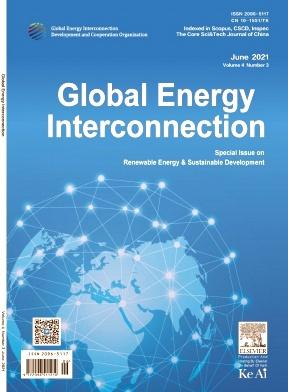屋顶分布式光伏热环境与能量效应模型仿真
IF 1.9
Q4 ENERGY & FUELS
引用次数: 0
摘要
屋顶分布式光伏(DPV)系统有望缓解夏季城市制冷需求造成的能源危机,并减轻与城市热岛相关的二次危害。在本研究中,屋顶dpv的参数化方案被纳入天气、研究和预报模型。以2022年8月12日至16日中国江苏省的热浪为天气背景,模拟不同发电效率的屋顶光伏对城市热环境和能源供应的影响。结果表明:(1)屋顶dpv通过减弱到达地表的太阳辐射降低了城市2 m处的气温;随着太阳能电池板效率的提高,冷却效果变得更加显著,尤其是在夜间。海拔2米的白天和夜间气温分别下降约0.1°C - 0.4°C和0.2°C - 0.7°C;(2)安装屋顶dpv可以降低边界层温度,白天(08:00可达0.7°C)和夜间(20:00可达0.6°C)降温效果显著;(3)如果所有建筑物都安装屋顶光伏,其发电量可以满足江苏省热浪期间的总电力需求。30%的发电效率和40%的屋顶光伏安装,产生的电力可以满足全部电力需求。本文章由计算机程序翻译,如有差异,请以英文原文为准。
Model simulation of thermal environment and energy effects of rooftop distributed photovoltaics
Rooftop distributed photovoltaic (DPV) systems show promise for alleviating the energy crisis resulting from summer urban cooling demands and mitigating secondary hazards associated with urban heat islands. In this study, a parametric scheme for rooftop DPVs was incorporated into the Weather, Research and Forecasting model. The period from August 12–16, 2022, during a heatwave in Jiangsu Province, China, was selected as the weather background to simulate the impact of rooftop DPVs with varying power generation efficiencies on urban thermal environments and energy supply. The results indicate that (1) rooftop DPVs reduce urban air temperatures at 2 m by weakening the solar radiation reaching the surface. As solar panel efficiency improves, the cooling effects become more significant, particularly at night. Day and night air temperatures at 2 m can decrease by approximately 0.1 °C–0.4 °C and 0.2°C–0.7 °C, respectively; (2) Installing rooftop DPVs can lower boundary layer temperatures, with pronounced cooling effects during the day (up to 0.7 °C at 08:00) and night (up to 0.6 °C at 20:00); (3) If all buildings are equipped with rooftop DPVs, the electricity generated could meet Jiangsu Province’s total electricity demand during heatwaves. With 30% generation efficiency and rooftop DPVs installed at 40% of buildings, the electricity produced can meet the entire electricity demand.
求助全文
通过发布文献求助,成功后即可免费获取论文全文。
去求助
来源期刊

Global Energy Interconnection
Engineering-Automotive Engineering
CiteScore
5.70
自引率
0.00%
发文量
985
审稿时长
15 weeks
 求助内容:
求助内容: 应助结果提醒方式:
应助结果提醒方式:


